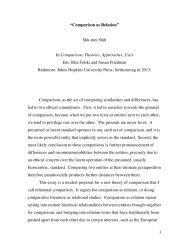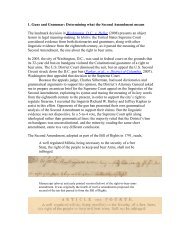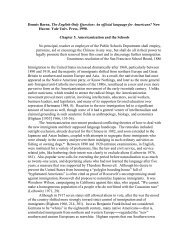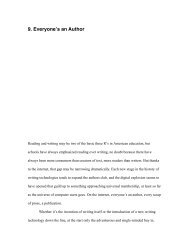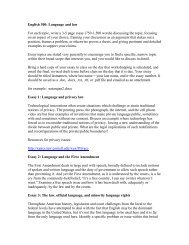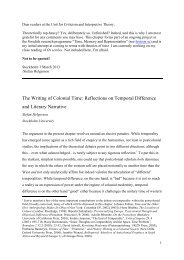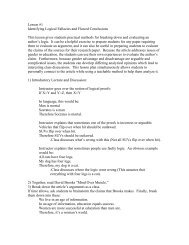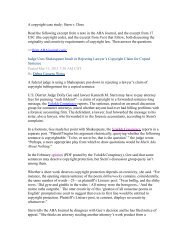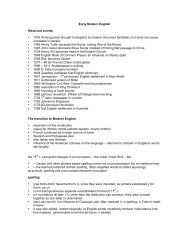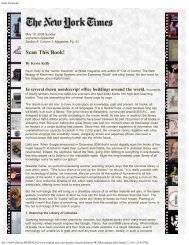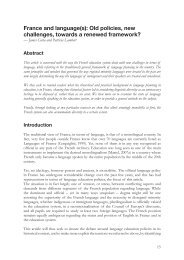Richard Posner: In Defense of Looseness - English
Richard Posner: In Defense of Looseness - English
Richard Posner: In Defense of Looseness - English
Create successful ePaper yourself
Turn your PDF publications into a flip-book with our unique Google optimized e-Paper software.
<strong>In</strong> <strong>Defense</strong> <strong>of</strong> <strong>Looseness</strong><strong>In</strong> these and other ways, the Heller decision is exposed as an example <strong>of</strong> loose construction--despite theCourt's pretense <strong>of</strong> engaging in originalist interpretation (but again, an originalism stripped <strong>of</strong> the originalunderstanding <strong>of</strong> how a constitutional provision should be interpreted). Just as when the Supreme Court,in 1947 in Adamson v. California, decided in the teeth <strong>of</strong> the language <strong>of</strong> the Fourteenth Amendment thatthe amendment "incorporates" the Bill <strong>of</strong> Rights, an exercise <strong>of</strong> judicial discretion is presented in Heller ashistorically determined. The Bill <strong>of</strong> Rights was added to the original Constitution to limit federal power.One provision <strong>of</strong> the Bill <strong>of</strong> Rights forbids government to deprive persons <strong>of</strong> life, liberty, or propertywithout due process <strong>of</strong> law. The Fourteenth Amendment contains an identical due process clause, butdirected against state action. The Court in Adamson turned historical handsprings to interpret theFourteenth Amendment's due process clause as incorporating--that is, making applicable to state action--most <strong>of</strong> the other provisions <strong>of</strong> the Bill <strong>of</strong> Rights. If Heller is applied to the states, it will be on theauthority <strong>of</strong> Adamson.The true springs <strong>of</strong> the Heller decision must be sought elsewhere than in the majority's declaredcommitment to originalism. The idea behind the decision--it is not articulated, <strong>of</strong> course, and perhaps noteven consciously held--may simply be that turnabout is fair play. Liberal judges have used looseconstruction to expand constitutional prohibitions beyond any reasonable construal <strong>of</strong> original meaning;and now it is the conservatives' turn. Another plausible example <strong>of</strong> payback is the conservative justices'expansive interpretation <strong>of</strong> the free-speech clause <strong>of</strong> the First Amendment to limit regulation <strong>of</strong> campaignfinancing.It is possible that in both the gun-control case and the campaign-finance cases the justices in themajority, rather than playing tit for tat, thought the laws they were invalidating very dumb, and in thecase <strong>of</strong> the District <strong>of</strong> Columbia's ban on possession <strong>of</strong> pistols thought the law wimpish and paternalistic,like requiring bikers to wear helmets. A law that bans possession <strong>of</strong> pistols outright may even be inferior,at least as a method <strong>of</strong> controlling crime, to a law that combines strict permit requirements with heavypenalties for violating them, or even to one that simply imposes draconian penalties on crimes committedwith guns. But judges are not supposed to invalidate laws merely because, as legislators, they would havevoted against them.There is an important difference, obvious but <strong>of</strong>ten overlooked, between using loose construction toprevent making the Constitution a straitjacket and using it to make the Constitution a straitjacket. <strong>In</strong>Kennedy v. Louisiana, a decision handed down shortly before Heller, the Supreme Court held that toexecute a person who rapes a child but does not kill her violates the cruel and unusual punishmentsclause <strong>of</strong> the Eighth Amendment. That was a loose construction that tied the hands <strong>of</strong> the states and thefederal government, and Scalia and the other conservative justices dissented. But in Heller it was theliberal justices who were dissenting from a decision that ties the hands <strong>of</strong> the federal government, and <strong>of</strong>the states, too, if the Supreme Court decides that the Second Amendment constrains state as well asfederal government action. Compare these two cases to the Zelman case, decided several years ago.There the Court upheld, against a challenge based on the clause <strong>of</strong> the First Amendment that forbidsgovernmental establishments <strong>of</strong> religion, the funneling <strong>of</strong> public monies to private schools by means <strong>of</strong>vouchers that parents can use to pay for their kids' tuition. Most private schools are Catholic parochialschools. The interpretation <strong>of</strong> the establishment clause that permitted the use <strong>of</strong> public moneys to financeparochial schools rejected the imposition on government <strong>of</strong> a constitutional restraint that the liberaljustices wanted to impose.Another illuminating contrast to Heller is the recent Kelo decision. The Supreme Court held that the justcompensation clause <strong>of</strong> the Fifth Amendment does not forbid a state to condemn private property and,having thus seized it, to turn it over to a private developer. The decision provoked outrage byconservatives, who oppose condemnation because it infringes rights <strong>of</strong> private property. They should nothave been outraged. All the Court did was unshackle government from a potential constitutionalconstraint, and by doing so toss the issue into the political arena. And sure enough, in the wake <strong>of</strong> thedecision a number <strong>of</strong> states, under pressure from property interests, curtailed their eminent domainpowers.http://www.tnr.com/story_print.html?id=d2f38db8-3c8a-477e-bd0a-5bd56de0e7c0 (3 <strong>of</strong> 6)8/14/2008 4:29:18 PM



